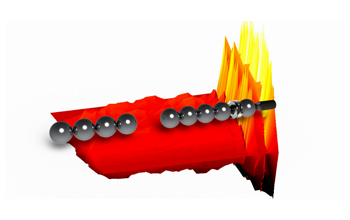Multimedia Gallery
Chain of Compressed Spheres
The nonlinearity and asymmetry present in this chain of compressed spheres can transform vibrations of one frequency, applied at one end of the chain, to vibrations with broadband frequency content leading to rectification. The amplitude of the vibrations is shown by the height of the peaks.
Although places like recording studios and hotel rooms can be built with materials that absorb or reflect sound, mechanisms that truly control the direction of sound waves are still in their infancy. However, researchers at the California Institute of Technology created the first tunable acoustic diode, a device that allows acoustic information to travel only in one direction, at controllable frequencies. The new mechanism brings the idea of true soundproofing closer to reality.
This research was supported by the National Science Foundation, the Office of Naval Research and the A. S. Onassis Benefit Foundation. To learn more, see the Caltech news story Caltech Engineers Develop One-way Transmission System for Sound Waves. (Date of Image: 2011)
Credit: Georgios Theocharis/Caltech
Images and other media in the National Science Foundation Multimedia Gallery are available for use in print and electronic material by NSF employees, members of the media, university staff, teachers and the general public. All media in the gallery are intended for personal, educational and nonprofit/non-commercial use only.
Images credited to the National Science Foundation, a federal agency, are in the public domain. The images were created by employees of the United States Government as part of their official duties or prepared by contractors as "works for hire" for NSF. You may freely use NSF-credited images and, at your discretion, credit NSF with a "Courtesy: National Science Foundation" notation.
Additional information about general usage can be found in Conditions.
Also Available:
Download the high-resolution JPG version of the image. (258 KB)
Use your mouse to right-click (Mac users may need to Ctrl-click) the link above and choose the option that will save the file or target to your computer.



